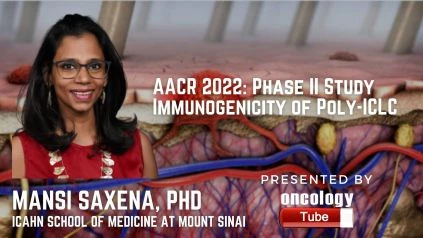Mansi Saxena, Ph.D., Associate Facility Director, Vaccine and Cell Therapy Laboratory at Icahn School of Medicine at Mount Sinai. In this video, she speaks about the AACR 2022 Abstract – CT108 / 5 – Immunogenicity of Poly-ICLC matured dendritic cells as an adjuvant for NY-ESO-1 and Melan-A-MART-1 peptide vaccination compared to Montanide® ISA-51 VG, in study subjects with melanoma in complete clinical remission but at high risk of disease recurrence.
Â
Observation –
Â
Origins:
Â
Dendritic cells (DCs) are essential in the anti-tumor immune response. Tumor-induced immunosuppression, on the other hand, promotes DC dysfunction and T cell exhaustion, culminating in tumor immunity evasion. The purpose of this study was to examine two methods for engaging DCs and generating an immune response to tumor antigens in the absence of tumor (melanoma)
Â
Methodologies:
Â
This is a randomized, Phase II open-label, two-arm trial comparing Arm A: Poly-ICLC-matured DC+PolyICLC to Arm B: Montanide ISA-51-VG+PolyICLC as adjuvants for NY-ESO-1 and Melan-A/MART-1 long peptides in patients with melanoma in complete clinical remission but at high risk of disease recurrence (NCT02334735). With the initial vaccine, each arm also got a helper peptide, keyhole limpet hemocyanin (KLH), and Poly-ICLC on day 2. 36 patients agreed to participate and were randomly assigned. Thirty-one patients were treated, with 16 in Arm A and 15 in Arm B. IHC was used to evaluate the expression of NY-ESO-1 and Melan-A/MART-1 as well as the immune infiltration landscape in the original tumors. ELISA, bulk TCR sequencing, and Olink were used to analyze cellular responses, TCR clonality, and inflammatory pathways, respectively. Ex-vivo functional T-cell responses were studied using the interferon (IFN)-g enzyme-linked immunospot assay (ELISPOT) and intracellular cytokine labeling after expansion.
Â
Outcomes:
Â
Arm B elicited a stronger humoral response against Melan-A/MART-1 and NY-ESO-1 than Arm A. Arm B also elicited a greater ex vivo IFN-g response as well as an increased CD4+ T cell response to NY-ESO-1. However, the response to Melan-A/MART-1 was equal in both arms, as determined by ex vivo ELISPOT and expanded CD4+T cell assays. Interestingly, while both arms had equal proportions of patients with a CD8+ T cell response to NYESO-1, Arm A had more patients with a CD8+ T cell response to Melan-A/MART-1 (9/16 in Arm A versus 4/14 in Arm B). Melan-A expression was found in 81% of the patients, however, it did not correlate with antigen-specific immune response. TCR sequencing, Olink analysis, and assessment of NY-ESO-1 expression and immune infiltrates in primary tumors are all underway.
Â
Conclude:
Â
The primary endpoints of safety and tolerability were met in this trial. Arm B elicited a greater antibody and CD4+ T cell response, particularly against NY-ESO-1, but Arm A appears to be more effective at eliciting CD8+ T cell responses against MelanA/MART1. The apparent increased CD8 T cell response in Arm A over Arm B could be attributable to the presence of certain HLA-I alleles in either arm to a pre-existing immunological response in some individuals. A further in-depth examination into the relationship between HLA type and cellular immune response to vaccination is underway.

